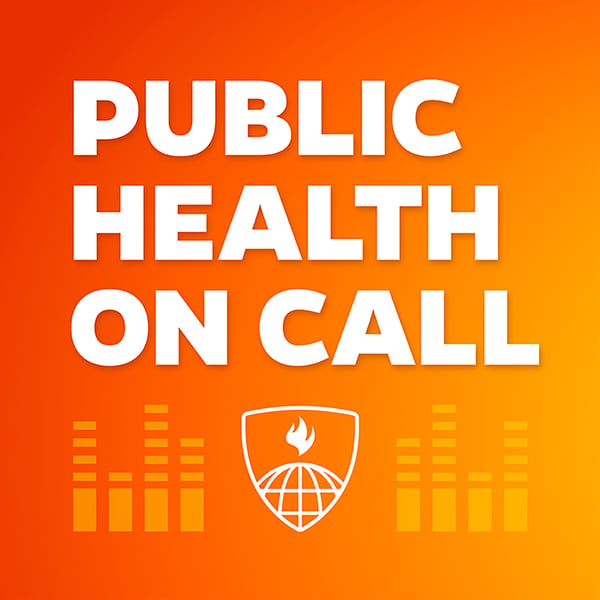919 - The Texas Floods and the Future of Forecasting
Public Health On Call
The Johns Hopkins Bloomberg School of Public Health
4.8 • 620 Ratings
🗓️ 16 July 2025
⏱️ 18 minutes
🧾️ Download transcript
Summary
About this episode:
The deadly Fourth of July floods in Kerr County, TX are raising urgent concerns about flash flooding risks and the future of storm response. In this episode: Hurricane specialist and storm surge expert Michael Lowry discusses what causes increasingly intense storms, details the significant strides made in forecasting, and outlines what’s at stake with potential cuts to NOAA.
Guest:
Michael Lowry is a hurricane specialist and storm surge expert for WPLG-TV in Miami, FL. He previously served as a senior scientist at the National Hurricane Center and as disaster planning chief at FEMA.
Host:
Lindsay Smith Rogers, MA, is the producer of the Public Health On Call podcast, an editor for Expert Insights, and the director of content strategy for the Johns Hopkins Bloomberg School of Public Health.
Show links and related content:
-
Trying to Make Sense of the Unspeakable Texas Tragedy—Eye on the Tropics
-
The Trump Administration Has Blinded Hurricane Forecasters—Intelligencer
-
Critical Hurricane Monitoring Data Is Going Offline—New York Times
Transcript information:
Looking for episode transcripts? Open our podcast on the Apple Podcasts app (desktop or mobile) or the Spotify mobile app to access an auto-generated transcript of any episode. Closed captioning is also available for every episode on our YouTube channel.
Contact us:
Have a question about something you heard? Looking for a transcript? Want to suggest a topic or guest? Contact us via email or visit our website.
Follow us:
-
Here's our RSS feed
Note: These podcasts are a conversation between the participants, and do not represent the position of Johns Hopkins University.
Transcript
Click on a timestamp to play from that location
| 0:00.0 | Welcome to Public Health On Call, a podcast from the Johns Hopkins Bloomberg School of Public Health, |
| 0:05.8 | where we bring evidence, experience, and perspective to make sense of today's leading health challenges. |
| 0:16.2 | If you have questions or ideas for us, please send an email to public health question at jhhhu.edu. |
| 0:23.7 | That's public health question at jhhhu.edu for future podcast episodes. |
| 0:31.0 | Hey listeners, it's Lindsay Smith Rogers. |
| 0:33.9 | Today, severe weather forecasting. |
| 0:36.8 | Hurricane specialist and storm surge expert Michael Lowry talks with me about the recent flash flood tragedy in Texas, how far hurricane and severe weather forecasting has come in the last 10 to 15 years, and how changes in funding and data availability may leave forecasters flying blind. Let's listen. Michael Lowry, thank you so |
| 0:56.6 | much for joining us on Public Health on Call. Tell us a little bit about your work. Yeah, I have a different |
| 1:02.0 | background. I'm a meteorologist by education, so I have a bachelor's and master's degree in meteorology |
| 1:07.9 | with a focus on tropical meteorology. But I've kind of worn three hats in my |
| 1:12.6 | career. I've been a researcher and scientist and forecaster, including time at the National Hurricane |
| 1:17.9 | Center. I have been an emergency manager, both at the state level for the state of Florida in the |
| 1:23.5 | very busy 2004-2005 hurricane seasons. And then I was a program manager heading up the |
| 1:29.5 | planning group at FEMA that oversees all of the disaster plans that are written, not just for |
| 1:34.9 | hurricanes, but hurricanes is kind of the bread and butter of FEMA. And then time as a broadcaster, |
| 1:39.5 | I was a hurricane expert and specialist for the weather channel on air, and then now I'm down here in |
| 1:44.8 | South Florida and Miami, where I'm their hurricane specialist and storm surge expert. |
| 1:49.3 | I've done a lot of work in storm surge research and modeling. |
| 1:52.1 | I've built many of the models at the National Hurricane Center uses to forecast storm surge. |
| 1:56.3 | And when I was down there, I was leading the team that developed all of these new products |
| 2:00.8 | and watches and warnings that were introduced specific for storm surge. |
| 2:04.7 | That's the deadly coastal part of a hurricane that's pushed ashore by the strong winds of a storm. |
... |
Please login to see the full transcript.
Disclaimer: The podcast and artwork embedded on this page are from The Johns Hopkins Bloomberg School of Public Health, and are the property of its owner and not affiliated with or endorsed by Tapesearch.
Generated transcripts are the property of The Johns Hopkins Bloomberg School of Public Health and are distributed freely under the Fair Use doctrine. Transcripts generated by Tapesearch are not guaranteed to be accurate.
Copyright © Tapesearch 2025.

